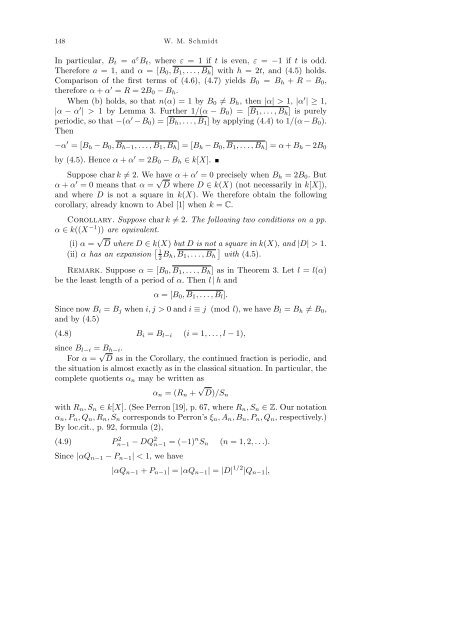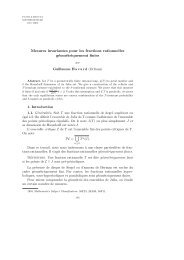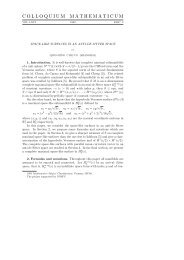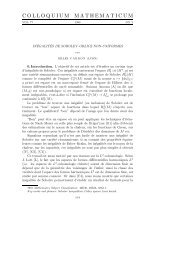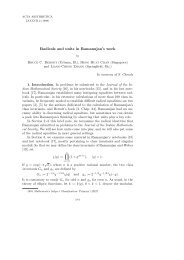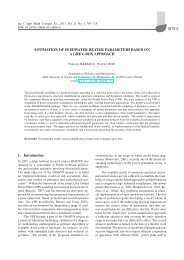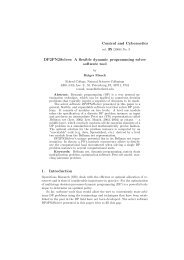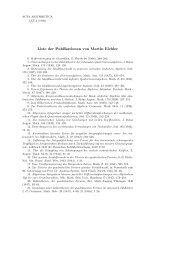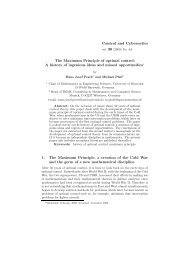On continued fractions and diophantine approximation in power ...
On continued fractions and diophantine approximation in power ...
On continued fractions and diophantine approximation in power ...
You also want an ePaper? Increase the reach of your titles
YUMPU automatically turns print PDFs into web optimized ePapers that Google loves.
148 W. M. Schmidt<br />
In particular, Bt = a ε Bt, where ε = 1 if t is even, ε = −1 if t is odd.<br />
Therefore a = 1, <strong>and</strong> α = [B0, B1, . . . , Bh] with h = 2t, <strong>and</strong> (4.5) holds.<br />
Comparison of the first terms of (4.6), (4.7) yields B0 = Bh + R − B0,<br />
therefore α + α ′ = R = 2B0 − Bh.<br />
When (b) holds, so that n(α) = 1 by B0 = Bh, then |α| > 1, |α ′ | ≥ 1,<br />
|α − α ′ | > 1 by Lemma 3. Further 1/(α − B0) = [B1, . . . , Bh] is purely<br />
periodic, so that −(α ′ − B0) = [Bh, . . . , B1] by apply<strong>in</strong>g (4.4) to 1/(α − B0).<br />
Then<br />
−α ′ = [Bh − B0, Bh−1, . . . , B1, Bh] = [Bh − B0, B1, . . . , Bh] = α + Bh − 2B0<br />
by (4.5). Hence α + α ′ = 2B0 − Bh ∈ k[X].<br />
Suppose char k = 2. We have α + α ′ = 0 precisely when Bh = 2B0. But<br />
α + α ′ = 0 means that α = √ D where D ∈ k(X) (not necessarily <strong>in</strong> k[X]),<br />
<strong>and</strong> where D is not a square <strong>in</strong> k(X). We therefore obta<strong>in</strong> the follow<strong>in</strong>g<br />
corollary, already known to Abel [1] when k = C.<br />
Corollary. Suppose char k = 2. The follow<strong>in</strong>g two conditions on a pp.<br />
α ∈ k((X −1 )) are equivalent.<br />
(i) α = √ D where D ∈ k(X) but D is not a square <strong>in</strong> k(X), <strong>and</strong> |D| > 1.<br />
(ii) α has an expansion 1<br />
2Bh, <br />
B1, . . . , Bh with (4.5).<br />
Remark. Suppose α = [B0, B1, . . . , Bh] as <strong>in</strong> Theorem 3. Let l = l(α)<br />
be the least length of a period of α. Then l | h <strong>and</strong><br />
α = [B0, B1, . . . , Bl].<br />
S<strong>in</strong>ce now Bi = Bj when i, j > 0 <strong>and</strong> i ≡ j (mod l), we have Bl = Bh = B0,<br />
<strong>and</strong> by (4.5)<br />
(4.8) Bi = Bl−i (i = 1, . . . , l − 1),<br />
s<strong>in</strong>ce Bl−i = Bh−i.<br />
For α = √ D as <strong>in</strong> the Corollary, the <strong>cont<strong>in</strong>ued</strong> fraction is periodic, <strong>and</strong><br />
the situation is almost exactly as <strong>in</strong> the classical situation. In particular, the<br />
complete quotients αn may be written as<br />
αn = (Rn + √ D)/Sn<br />
with Rn, Sn ∈ k[X]. (See Perron [19], p. 67, where Rn, Sn ∈ Z. Our notation<br />
αn, Pn, Qn, Rn, Sn corresponds to Perron’s ξn, An, Bn, Pn, Qn, respectively.)<br />
By loc.cit., p. 92, formula (2),<br />
(4.9) P 2 n−1 − DQ 2 n−1 = (−1) n Sn (n = 1, 2, . . .).<br />
S<strong>in</strong>ce |αQn−1 − Pn−1| < 1, we have<br />
|αQn−1 + Pn−1| = |αQn−1| = |D| 1/2 |Qn−1|,


